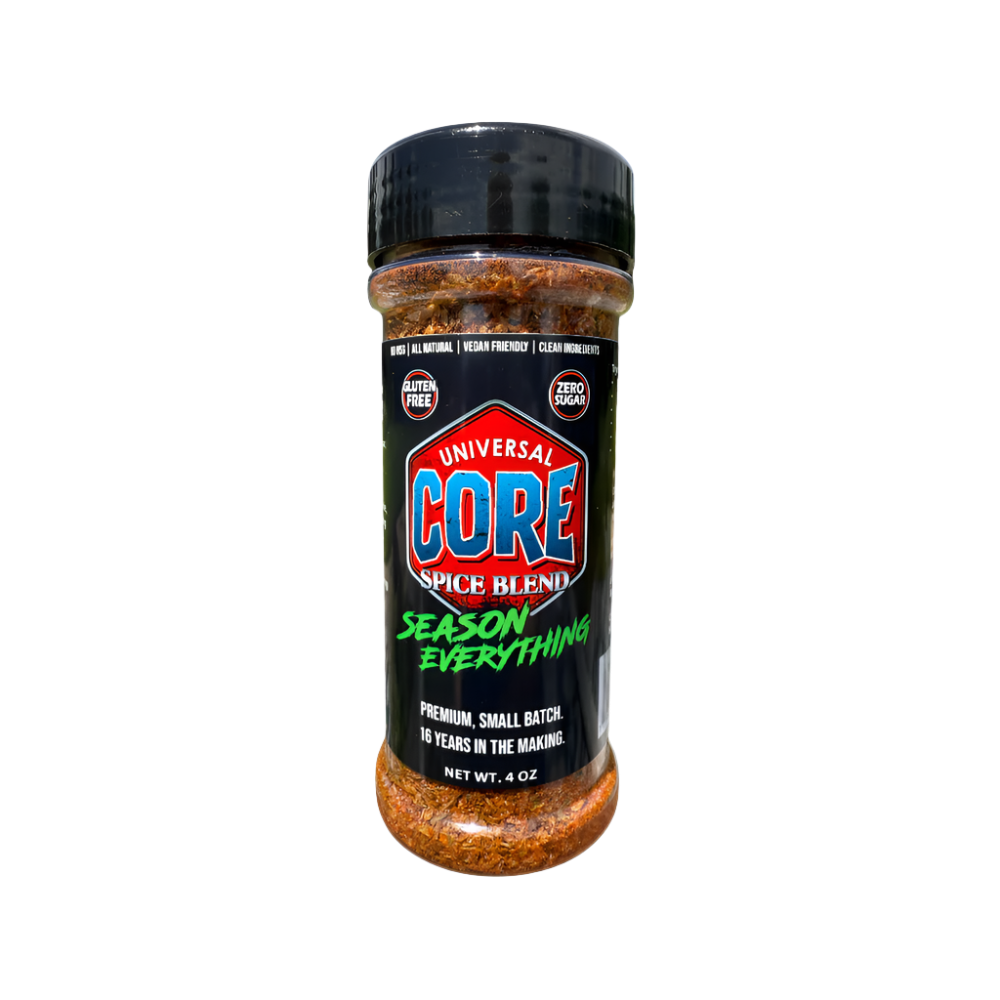You nailed the shopping trip, grabbed a nice steak, heated the pan like a pro…and still wound up sawing through a chewy dinner. Before you blame the cow, here’s the real story: steak doesn’t usually start “tough”—it gets tense when we rush heat, mistime salt, or miss a couple tiny details that matter more than you think.
This is the cook’s guide to turning tension into tenderness—plus how a smart, all-in-one seasoning (hello, Core Spices Universal Spice Blend) quietly does half the job for you.
The Short Version (so dinner isn’t late)
-
Pat the steak dry. Season generously (either 45–60 minutes ahead or right before the pan—not “a little while” before).
-
Get the pan ripping hot, but don’t crowd it. Sear both sides. Lower the heat to finish.
-
Pull it before your final temp (carryover is real). Rest briefly. Slice across the grain.
-
Use a balanced seasoning that helps with browning and flavor perception so the bite feels tender and rich.
If you want the why, keep reading.
What’s Actually Making Steak Chewy?
Think of steak like a bundle of elastic bands (muscle fibers) wrapped with some connective tissue.
-
Rapid heat = fibers seize up. A hard, uncontrolled blast from edge to center pushes out moisture and tightens the bite.
-
Gray band syndrome. Super-hot outside + slow middle creates a thick, overcooked ring just beneath the crust.
-
Under-salted = underwhelming. Salt isn’t just flavor; it changes how proteins hold onto water. Too little and the meat cooks “stiff.”
-
Sliced with the grain. Cut the wrong way and you keep those long fibers intact—chewier by default.
The Three Moments That Decide Tenderness
-
Salt Timing (either early…or right now)
-
Early (dry brine): Season generously and chill uncovered 45–60 minutes (or longer). The salt dissolves, diffuses inward, and helps proteins hold water. Bonus: drier surface = better sear.
-
Right before cooking: If you missed the window, salt heavily just before the steak hits the pan.
-
Avoid the mushy middle: Salting 10–20 minutes before cooking is the worst of both worlds—salt has pulled out moisture but hasn’t reabsorbed.
-
Sear vs. Cook
-
High-heat sear for color and flavor (Maillard reaction) first.
-
Gentle finish to your preferred doneness (lower burner or move to the cooler side of the grill/oven). That prevents the gray band and keeps the interior relaxed.
-
The Pull + Rest
-
Heat doesn’t stop when you stop. Pull the steak 3–5°F before your target. Rest 5–10 minutes so juices redistribute. Then slice against the grain.
What Your Seasoning Can Actually Do (When It’s Built Right)
A good universal blend isn’t just “flavor dust.” It helps the physics along:
-
Salt sets the stage for moisture retention and even seasoning through the first few millimeters.
-
Aromatics and warming spices bloom in hot fat, amplifying browning and that steakhouse crust.
-
Perception hack: certain spice notes intensify aroma and saliva production, which your brain translates as “juicier” and “more tender.”
That’s the quiet advantage of Core Spices Universal Spice Blend—you get the right balance in one shake, without juggling five jars or guessing ratios.
(We’re not listing the exact components here—proprietary blend, by design.)
Choose Your Path: Thin vs. Thick
Thin cuts (under 1 inch):
-
Blaze-hot pan, 60–90 seconds per side.
-
Maybe a quick baste, then off the heat. Rest briefly.
-
Doneness happens fast; start checking almost immediately.
Thick cuts (1¼–2 inches):
-
Reverse-sear shines here: gentle oven (250–275°F) to ~10°F below target, then a hard, fast sear in a hot pan or on the grill.
-
Or sear first, then finish low—same idea, smaller gray band.
Tiny Fixes That Make a Big Difference
-
Start dry. Paper towels are your friend. Wet steak steams, dry steak browns.
-
Don’t crowd the pan. Two steaks in a small skillet = sauna, not sear.
-
Flip more than once. Old myths die hard; frequent flips can cook more evenly and reduce the gray band.
-
Mind your fat. Use a high-smoke-point oil for the sear; save the butter for the last minute if you like basting aromas.
-
Know your numbers.
-
Pull at ~120–125°F if you like rare (finishes a bit higher).
-
~125–130°F for medium-rare pull (finishes ~130–135°F).
-
~135–140°F for medium pull (finishes ~140–145°F).
Use these as guides; your pan, steak thickness, and timing all matter.
-
A Pan-to-Plate Flow You Can Memorize
-
Unwrap steak. Pat dry. Season generously with Core Spices (either 45–60 min ahead, or right before cooking).
-
Heat a cast-iron pan until it just starts to smoke. Add a thin film of high-heat oil.
-
Sear 60–90 seconds per side to develop color.
-
Lower heat (or move to a 275°F oven) and finish to your pull temp.
-
Optional: quick butter baste in the last 30 seconds.
-
Rest 5–10 minutes. Slice across the grain. Sprinkle a touch more Core Spices if you like a finish. Eat proudly.
The Real Takeaway
Great steak isn’t a mystery. It’s muscle behavior, heat management, and a seasoning that does more than taste good. Relax the meat, manage the sear, slice it right—and let Core Spices Universal Spice Blend carry the flavor and browning so the whole bite feels tender.
Ready to upgrade steak night without babysitting ten spice jars?
Order Core Spices Universal Blend Now! and make the best part of dinner the easiest step.

